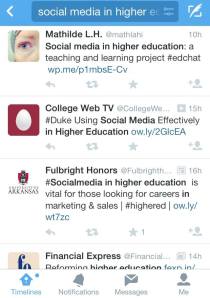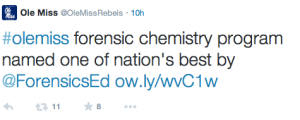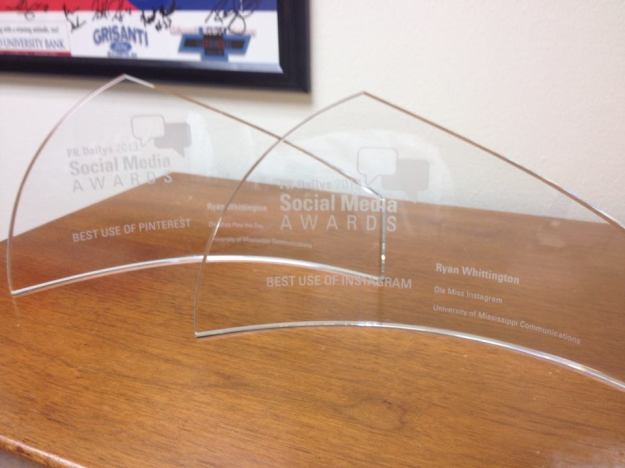Social media has made its way into college courses as a teaching tool and is taking a front seat in higher education inside the classroom, outside the classroom, and beyond.
Inside the classroom:
According to the study, Teaching, Learning and Sharing, How Today’s Higher Education Faculty Use Social Media by Pearson Learning Solutions, the Babson Survey Research Group, and Converseon in April 2011 two-thirds of all faculty have used social media during class, and 30 percent have posted something for students to read on their own time. More than 40 percent of faculty members have assigned students to read or view social media as part of a course requirement, and 20 percent have issued students to comment or post to a social media platform.
Social Media platforms that used to be banned by teachers and seen as distractions to students are now entering many college classrooms at Ole Miss as a permanent teaching tool, not just a substitute.

Facebook helped me find how students and teachers are using social media at Ole Miss as a teaching tool
Dr. David McElreath a professor of legal studies at the University of Mississippi uses YouTube in his Criminal Justice Emergency Management class as a teaching tool. “The reason I do is I think a lot of students benefit from the use of visuals, “ said McElreath via phone interview. When discussing homeland security in class McElreath uses relevant Youtube videos to grab student’s attention and show rather than tell. “It captures their attention, the concept disappears if I’m talking at them about border violence in Bishop Hall,” said McElreath via phone interview. 40 years ago there were slide projectors but now McElreath is embracing online video in his lesson plans, in fact Youtube is one of the most popular uses of social media among college professors. “The internet has proved to be a wealth of resources, why should we not try to tap it if we can use it in the learning experience?” said McElreath via phone interview.
For Lauren Portice a rising Senior and an Intergrated Marketing Communications major at Ole Miss, Facebook isn’t just a place to post pictures and share her shocking BuzzFeed quiz results, she also uses Facebook for her Editing by Design class. In fact, the class has their very own Facebook page. “I like having the Facebook page for my class because it is constantly being updated by the teacher and fellow students,” said Portice. By logging into her Facebook account and clicking the group page Portice is able to bounce ideas off of other students and post questions.
“The benefits of this Facebook page is mostly being able to ask questions and see questions and answers that students of I have instantly,” said Portice. Portice wishes her other classes would operate in a way that uses social media. “I absolutely believe that other classes should incorporate social media since this medium is growing vastly. It is easy, convenient, and accessible,” said Portice.
Charles D. Mitchell, assistant dean of the University of Mississippi Meek School of Journalism and New Media, views this recent wave of social media in higher education as full of possibilities. “I think it’s pretty exciting. My first year in college a student could be expelled from the university if caught using a calculator. By the time I graduated, calculators were required for many courses,” said Mitchell via email. Much like the evolution of pocket calculators in the classroom social media has grown from an out law to welcomed. The benefits of the power of social media in the classroom is moving from what once was guessing to now knowing. “The main thing is that if used properly, social media can be an enhancement to classroom learning,” said Mitchell via email.
Outside the classroom and beyond:
Social Media platforms are enhancing higher education in the classroom but are also an essential tool outside the classroom as well. Ryan Whittington, Assistant Director of Public Relations for Social Media Strategy at the University of Mississippi knows a thing or two about social media in higher education, considering he is the man behind the official Ole Miss twitter account, @OleMissRebels.
For Whittington social media is used as a tool in more ways than one. One is for reputation management of the university. With everyone being on twitter these days it is important not to be overshadowed by anyone else. In order to do this there must be strategy involved. “We want to make sure our message is out there and is presented in a way in which we want it presented so we have a presence on twitter,” said Whittington.
Another useful aspect of social media is research gathering. “We can see what people are talking about and we want to know what they want to see and we also want to know that they want to hear from us so we use twitter,” said Whittington. On the @OleMissRebels account Whittington follows a cross section of the Ole Miss community from faculty, staff, and students to parents, alumni, and fans. “I follow them because I want to know what they are talking about and that tell us what we should be talking about,” said Whittington
Whttington’s job title alone shows how much of an integral part social media now plays in higher education. It is important that universities are sharing their message with their audience, for Ole Miss it is no different. “The overarching message on all our social media platforms is to show people that we have individuals who attend Ole Miss who are leaders and will be leaders in their career, they are excellent academically, and also have a desire to be community servants while they are at Ole Miss and after they leave. We also want to show that Ole Miss is a very accessible university,” said Whittington. The strategy is in how those messages are shared to each different audience on each different platform. “We can show that we are excellent academically by sharing photos of our students winning cool awards. We can show photos of people being community servants at the Big Event, and we can show that we are accessible because we have such a diverse student body, and we can share photos of that diverse student body on Instagram,” said Whittington.
In what used to be a pamphlet and mail driven process for prospective college students researching colleges now is a process driven by looking up colleges digitally. According to cursivecontent.com, 66 percent of prospective college students believe schools should have a social media presence. 68 percent of high school students use social media to research schools, 38 percent have used social media as a resource when deciding where to enroll, and 45 percent said they have been influenced by a school’s engagement on social media. With the admissions department and university recruiters having their own social media accounts through Ole Miss’s admissions department, it is Whittington’s job to amplify their messages and provide a virtual tour of Ole Miss to those prospective students who can’t be on campus every single day. “Whether it’s sharing a photo of the grove, telling them about a cool forensic chemistry program that they can be apart of, or sharing with them that we had Nelly in the grove,” said Whittington.
An Instagram picture maybe worth 1,000 words but the real power lies in using 140 characters. “Twitter is an extremely powerful tool especially in the realm of higher education,” said Whittington. This short and concise post has the ability to share, link, and portray tone, which is exactly what people in the 21st century want: quick news. “People don’t want to read a 450 word press release they want to read 140 characters,” said Whittington.
Twitter allows people to gather information quickly and to also see the things they only want to see and not be bombarded by spam messages. “We have advanced to a point in our society where we are constantly on our tablets, cell phones, and computers and we don’t have time to read, as sad as it is. But we do have time to gather information, and that’s what people want more information,” said Whittington.
Ole Miss has kept up with the always-updating world of social media, but there still is plenty of room to grow. “The world of social media is very new to not only the University of Mississippi but higher education in general,” said Whittington. Having to adapt as quickly as an audience is a task. “How far we have come in nine years is a lot for a public relations communications person, but in the big scheme of things it’s not for someone who is 16, 17, or 18 years old. We have to adapt just as quickly as our audience is and some cases a lot quicker,” said Whittington. For Whittington, he would love to get the University of Mississippi involved in other forms of social media and that will come in time, for right now Whittington focuses on managing the ones he knows the students are interacting on. “We are also always looking for that next big social media network that will be coming, that takes up a lot of my job, researching the next big thing,” said Whittington.
While searching for the next big thing Whittington also has to focus on growing the University’s fans and followers. The trick is in the photos. “The use of photos on all of our social platforms are really what drives growth, fans, and followers,” said Whittington. It is different for every university and medium. On Facebook, photos of football after a big win over LSU really work attracting people.
Social media is a world in of itself in higher education. Each university and college campus in the United States has a distinct message they want to share and a massive audience following their every move. For example, Harvard University has more than two million Facebook fans Texas A&M has more than 100,000 followers on Twitter. “It’s interesting to me to interact with these individuals who run these accounts from all over the country, I would have never imagined before I got this job how intense and how serious they take their jobs, as they should, and I also didn’t know it was a world that was there,” said Whittington. For Whittington, it is also interesting to see the strategy of social media in higher education. “I always saw official university accounts as, ‘oh that’s the man trying to talk to me,’ that was from 2005 to 2009 when I was an undergrad here, but the world has evolved so much and the world of technology has evolved so much on social media that now universities can’t afford to have that type of perception around each of their official accounts. They have to be seen as a persona and someone has to spend a lot of time to develop these personas on social media,” said Whittington.
The hard work behind the Instagrams, tweets, and Pintrest pins is paying off. Ole Miss won two awards from PR Daily, a national publication. With social media awards every year these awards are given to organizations or institutions that display outstanding knowledge of the platforms. Ole Miss won awards for the their Pintrest page and for best use of Instagram. “It feels good to be awarded for something we put a lot of work into behind the scenes,” said Whittington.
Listen to the soundbyte below to hear Whittington talk about how incidents on campus are dealt with on social media at Ole Miss:






